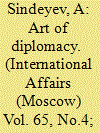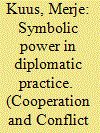| Srl | Item |
| 1 |
ID:
167763


|
|
|
|
|
| Summary/Abstract |
THE BASIC OBJECTIVES of diplomacy do not change with the passing of time. Diplomacy is tasked with securing conditions for maintaining and developing the state, society and its inherent culture. This simple assertion requires three clarifications: Diplomats are generally the first to deal with problems and potential conflicts that arise, which means they are the first line of defense of that country's interests; as state officials, diplomats act within set frameworks, and independence and improvisation are a rather rare and perforce exceptions to the rule; national interests are almost always stable and have nothing to do with the political regime in the country.
|
|
|
|
|
|
|
|
|
|
|
|
|
|
|
|
| 2 |
ID:
141725


|
|
|
|
|
| Summary/Abstract |
This paper investigates the workings of symbolic power in diplomatic practice. At the level of empirical observation, it focuses on the intangible and incalculable ‘feel for the game’ that distinguishes a well-informed and relaxed insider from an ill-informed and ill-at-ease outsider in European Union (EU) diplomatic circles in Brussels. By highlighting the play of social resources, such as reputation, presence, poise, and composure in these circles, I examine EU diplomacy from an angle – symbolic power – that is often overlooked in the existing work on that field. Conceptually, the analysis focuses on the role of informal social resources rather than formal institutional structures in diplomatic practice. It also outlines the potential synergies between the study of diplomacy in international relations (IR) on the one hand and geography, anthropology, and sociology on the other. The paper thereby advances the analytical toolbox of diplomatic studies and practice theory. Such conceptual sharpening is needed, especially now that diplomacy is becoming more transnational and less linked to the foreign ministries of states.
|
|
|
|
|
|
|
|
|
|
|
|
|
|
|
|